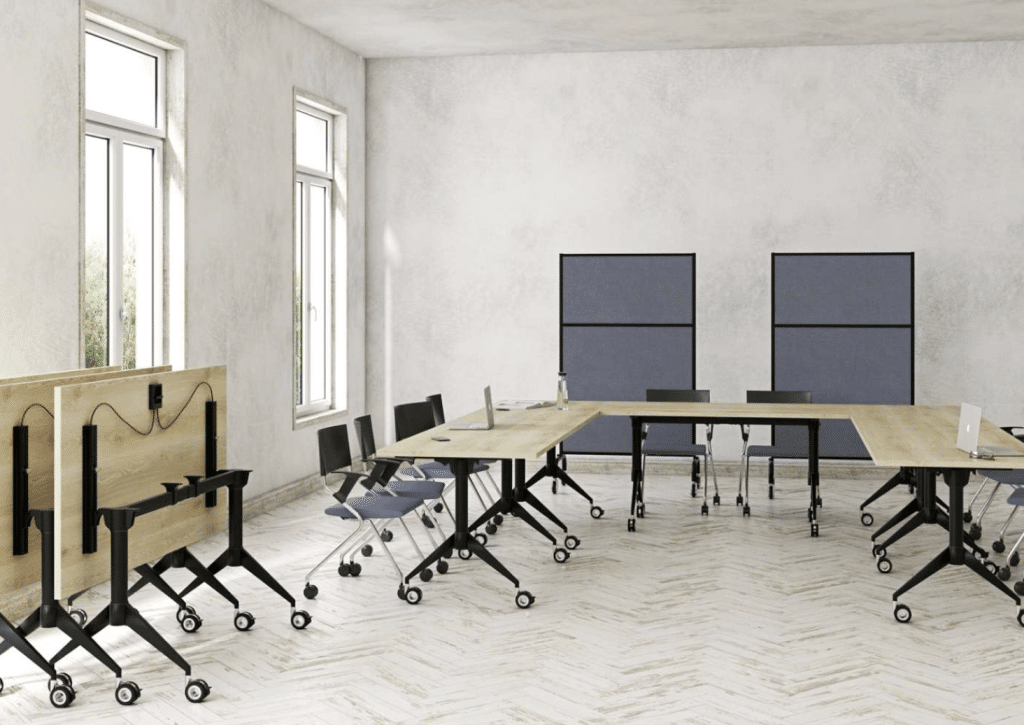Training tables are versatile pieces of business furniture that offer numerous benefits. They are ideal for seminar rooms, conference spaces and employee training areas.
Today’s employees want flexibility in how they work, learn and communicate. This means they want personalization, collaboration and real-time feedback. Mobile learning offers these benefits.
Durable
A training table is a durable solution to help improve meeting, seminar and collaboration productivity. Its functional design allows for easy reconfiguration as needed. It features a wear-resistant melamine top, strong 1.5″ offset dual legs, and a perforated modesty panel. It can be outfitted with power options to facilitate USB, HDMI and other electrical connections. It is available in a grey top with charcoal legs and a mahogany top with black legs.
While remote training is a great opportunity to boost employee engagement, it can also be an issue if not implemented correctly. People ops leaders, managers and HR must ensure that remote training is dynamic and engaging for team members. This can be done by providing that every team member has a personalized learning path, one-to-one meetings and feedback are captured, and communication is open between managers and their direct reports.
Portable
With so many employees working from home, managers must invest in training for remote workers. Using online learning platforms with content that engages and teaches new skills to remote team members is an excellent way for leaders to support their teams. These platforms also enable people to access company guidelines and training materials from any location and device, fighting feelings of isolation.
While eLearning is great for visual learners who prefer videos and infographics, it could be more effective for practical tasks that require hands-on practice. One of the best ways to combat this limitation is by adding teamwork activities into your remote training programs. These can include live-video conferences, where employees can discuss a new task and help one another solve technical issues. Alternatively, you could incorporate a Jeopardy-style quiz game, where employees can compete against one another for points and see who has the most knowledge about a subject matter.
Whether your training program involves a lecture-style format or discussion-based learning, you can use portable training tables to create the right layout. These slender, rectangular tables come in various styles and colors to match your classroom or meeting room decor. They also feature locking casters on the ends, making it easy to move them around your room.
Convenient
A mobile table is an ideal workspace for remote teams when training requires notetaking, research, or online activities. These slender, rectangular tables can be arranged in rows to mimic the style of a university lecture or set up in a U-shape for discussion-based learning. Some versions come with power and digital cable features for added convenience.
With the coronavirus pandemic requiring people to self-quarantine and practice social distancing, remote work will likely become the new normal for many organizations. In this situation, it’s more important than ever that remote workers feel cared for and included by leadership. HR managers must ensure that their remote learning programs are dynamic and engaging to help boost morale.
Providing easy-to-access training resources that are compatible with mobile devices is an essential part of this. For example, remote employees often use smartphones to access business memos and instructions, so make sure your training materials are easily accessible from this format.
Similarly, consider adding gamification elements to your remote training program. This will keep employees interested and engaged and encourage them to watch or complete company-mandated training. For instance, try implementing a points system where each employee can earn rewards for watching or completing training courses. You can also create a group chat or discussion board on your learning platform to allow team members to share their progress and discuss their learning.
Aesthetics
Aesthetically, training tables have a simple elegance that fits well in many collaborative environments. You may find them in classrooms where a teacher can facilitate close instruction or in an office setting that promotes creative discussion of ideas. They are a great way to bring collaboration into physical space, which studies show can increase productivity more than just communicating online.
A training table can be arranged in rows for a typical conference room setup or in a U-shape to encourage conversation and participation among the group. You can also configure them in a circle to promote more inclusive discussions and participant equality. Some trainers even use them as a board for writing and brainstorming projects. They are a good option for teams who need to work together but need a little more separation than an ordinary desk or conference table.
You can choose from various colors and sizes of training tables to fit your specific needs. Some brands offer training tables with ganging connectors to create semi-permanent configurations. Other brands feature a modular design that rolls, folds and stores easily, making it easy to reconfigure a collaborative workspace. The modular training table features a central lever for rapid folding and a built-in modesty panel to provide more privacy for users.
Collaboration doesn’t just happen in conference settings. It can also occur during an impromptu team lunch, an offsite retreat or a quick touch-base meeting in a lounge area. It would help to have multipurpose solutions like the mobile and flexible Everywhere training table. With a refined aesthetic and multiple configuration options, you can create a formal learning environment or a more casual one for any application.

